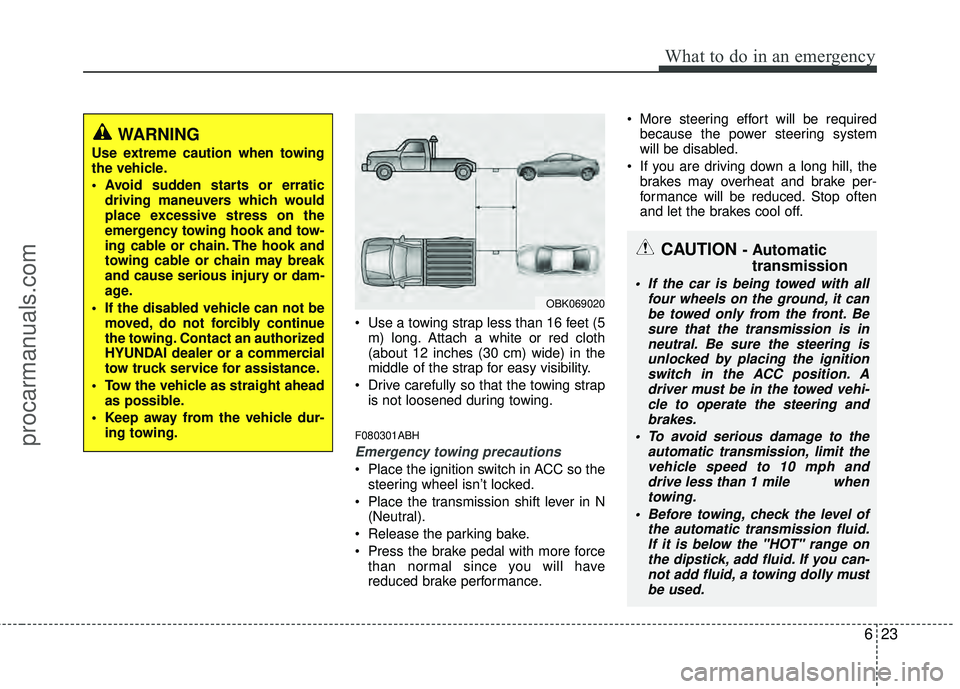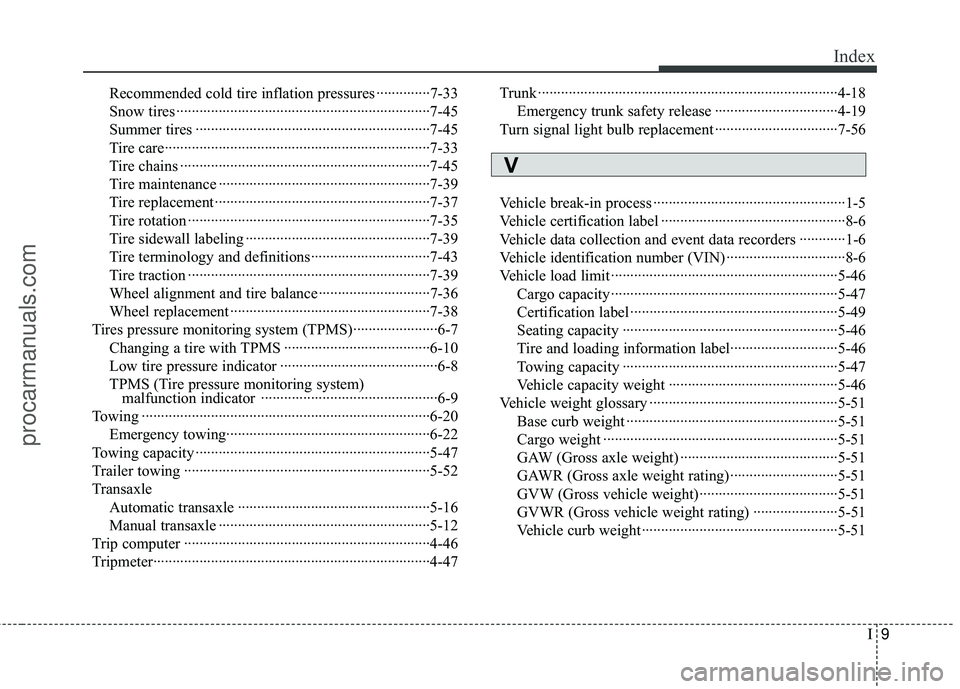2012 HYUNDAI COUPE towing
[x] Cancel search: towingPage 302 of 391

623
What to do in an emergency
Use a towing strap less than 16 feet (5m) long. Attach a white or red cloth
(about 12 inches (30 cm) wide) in the
middle of the strap for easy visibility.
Drive carefully so that the towing strap is not loosened during towing.
F080301ABH
Emergency towing precautions
Place the ignition switch in ACC so thesteering wheel isn’t locked.
Place the transmission shift lever in N (Neutral).
Release the parking bake.
Press the brake pedal with more force than normal since you will have
reduced brake performance. More steering effort will be required
because the power steering system
will be disabled.
If you are driving down a long hill, the brakes may overheat and brake per-
formance will be reduced. Stop often
and let the brakes cool off.
WARNING
Use extreme caution when towing
the vehicle.
driving maneuvers which would
place excessive stress on the
emergency towing hook and tow-
ing cable or chain. The hook and
towing cable or chain may break
and cause serious injury or dam-
age.
If the disabled vehicle can not be moved, do not forcibly continue
the towing. Contact an authorized
HYUNDAI dealer or a commercial
tow truck service for assistance.
Tow the vehicle as straight ahead as possible.
Keep away from the vehicle dur- ing towing.
OBK069020
CAUTION - Automatictransmission
If the car is being towed with all
four wheels on the ground, it canbe towed only from the front. Be sure that the transmission is inneutral. Be sure the steering is unlocked by placing the ignitionswitch in the ACC position. A driver must be in the towed vehi-cle to operate the steering andbrakes.
To avoid serious damage to the automatic transmission, limit thevehicle speed to 10 mph anddrive less than 1 mile when
towing.
Before towing, check the level of the automatic transmission fluid.If it is below the "HOT" range onthe dipstick, add fluid. If you can- not add fluid, a towing dolly mustbe used.
procarmanuals.com
Page 314 of 391

Maintenance
12
7
G040200ABK-EU
MAINTENANCE UNDER SEVERE USAGE CONDITIONS
ENGINE OIL AND FILTER
AIR CLEANER FILTER
SPARK PLUGS
MANUAL TRANSMISSION FLUID
AUTOMATIC TRANSMISSION FLUID
BRAKE/PADS, CALIPERS AND ROTORS
REAR DISC BRAKE/PAD, PARKING BRAKE
STEERING GEAR BOX, LINKAGE & BOOTS/
LOWER ARM BALL JOINT, UPPER ARM BALL JOINT
DRIVE SHAFTS AND BOOTS
REAR AXLE OIL
CLIMATE CONTROL AIR FILTER
(FOR EVAPORATOR AND BLOWER UNIT)
PROPELLER SHAFT 2.0 TCI
3.8
R
R
R
R
R
R
I
I
I
I
R
R
I EVERY 3,000 MILES (5,000 KM) OR 3 MONTHS
EVERY 3,750 MILES (6,000 KM) OR 6 MONTHS
MORE FREQUENTLY
MORE FREQUENTLY
EVERY 80,000 MILES (120,000 KM)
EVERY 62,500 MILES (100,000 KM)
MORE FREQUENTLY
MORE FREQUENTLY
MORE FREQUENTLY
EVERY 7,500 MILES (12,000 KM) OR 6 MONTHS
EVERY 60,000 MILES (96,000 KM)
MORE FREQUENTLY
EVERY 7,500 MILES (12,000 KM) OR 6 MONTHSA, B, C, D, E, F, G, H, I, K
C, E
B, H
C, D, E, G, H, I, J
A, C, F, G, I
C, D, G, H
C, D, G, H
C, D, E, F, G, H, I
C, D, E, F, H
C, G, H, I, J
C, E
C, E
MAINTENANCE ITEM
MAINTENANCE
OPERATION MAINTENANCE
INTERVALS DRIVING
CONDITION
The following items must be serviced more frequently on cars normally used under severe driving conditions. Refer to the chart below for the appropriate maintenance intervals.R : Replace I : Inspect and, after inspection, clean, adjust, repair or replace if neces\
sary
SEVERE DRIVING CONDITIONS
A - Repeatedly driving short distance of less than 5 miles (8 km) in normal temper- ature or less than 10 miles (16 km) in freezing temperature
B - Extensive engine idling or low speed driving for long distances
C - Driving on rough, dusty, muddy, unpaved, graveled or salt- spread roads
D - Driving in areas using salt or other corrosive materials or in very cold weather
E - Driving in sandy areas F - Driving in heavy traffic area over 90°F (32°C)
G - Driving on uphill, downhill, or mountain road
H - Towing a Trailer, or using a camper, or roof rack
I - Driving as a patrol car, taxi, other commercial use or vehicle towing
J - Driving over 106 mph (170 km/h)
K - Frequently driving in stop-and-go conditions
procarmanuals.com
Page 385 of 391

Index
4I
Door locks··················\
··················\
··················\
················4-15Central door lock switch ··················\
··················\
·······4-17
Driver's air bag··············\
··················\
··················\
·············3-44
Driving at night··················\
··················\
··················\
········5-39
Driving in flooded areas ··················\
··················\
············5-40
Driving in the rain ··················\
··················\
··················\
···5-40
Economical operation ··················\
··················\
················5-56
Electric chromic mirror (ECM) ··················\
··················\
·4-33
Electronic stability control (ESC) ··················\
···············5-27
Emergency starting ··················\
··················\
··················\
····6-4 Jump starting ··················\
··················\
··················\
·········6-4
Push starting ··················\
··················\
··················\
··········6-5
Emergency trunk safety release ··················\
··················\
·4-19
Emergency towing ··················\
··················\
··················\
···6-22
Emergency while driving··················\
··················\
·············6-2
Emission control system ··················\
··················\
············7-67 Crankcase emission control system ··················\
········7-67
Evaporative emission control (including ORVR) System ··················\
··················\
··················\
··············7-67
Exhaust emission control system ··················\
············7-68
Engine compartment ··················\
··················\
············2-4, 7-2
Engine coolant ··················\
··················\
··················\
·········7-17
Engine number ··················\
··················\
··················\
···········8-7
Engine oil ··················\
··················\
··················\
·················7-16\
Engine overheats··················\
··················\
··················\
········6-6 Engine start/stop button ··················\
··················\
···············5-7
Engine temperature gauge ··················\
··················\
·········4-44
Engine will not start··················\
··················\
··················\
···6-3
Evaporative emission control (including ORVR)
System ··················\
··················\
··················\
·················7-67\
Exhaust emission control system··················\
·················7-68\
Explanation of scheduled maintenance items ···············7-13
Exterior care··················\
··················\
··················\
·············7-61
Flat tire ··················\
··················\
··················\
··················\
···6-12 Changing tires ··················\
··················\
··················\
·····6-13
Compact spare tire ··················\
··················\
················6-18
Jack and tools ··················\
··················\
··················\
······6-12
Removing and storing the spare tire ··················\
·······6-13
Floor mat anchor(s) ··················\
··················\
··················\
·4-97
Fluid Brake/clutch fluid ··················\
··················\
··················\
7-20
Power steering fluid ··················\
··················\
··············7-21
Washer fluid ··················\
··················\
··················\
········7-22
Folding the rear seat ··················\
··················\
··················\
3-11
Front fog light bulb replacement ··················\
·················7-56\
Front seat adjustment - manual ··················\
··················\
···3-4
Front seat adjustment - power ··················\
··················\
·····3-9
Fuel filler door ··················\
··················\
··················\
·········4-25
Fuel gauge··················\
··················\
··················\
················4-45
Fuel requirements ··················\
··················\
··················\
······1-3
E
F
procarmanuals.com
Page 390 of 391

I9
Index
Recommended cold tire inflation pressures ··············7-33
Snow tires ··················\
··················\
··················\
············7-45
Summer tires ··················\
··················\
··················\
·······7-45
Tire care··················\
··················\
··················\
···············7-33
Tire chains ··················\
··················\
··················\
···········7-45
Tire maintenance ··················\
··················\
··················\
·7-39
Tire replacement ··················\
··················\
··················\
··7-37
Tire rotation ··················\
··················\
··················\
·········7-35
Tire sidewall labeling ··················\
··················\
············7-39
Tire terminology and definitions··················\
·············7-43
Tire traction ··················\
··················\
··················\
·········7-39
Wheel alignment and tire balance ··················\
···········7-36
Wheel replacement ··················\
··················\
················7-38
Tires pressure monitoring system (TPMS)··················\
····6-7 Changing a tire with TPMS ··················\
··················\
··6-10
Low tire pressure indicator ··················\
··················\
·····6-8
TPMS (Tire pressure monitoring system) malfunction indicator ··················\
··················\
··········6-9
Towing ··················\
··················\
··················\
··················\
···6-20 Emergency towing··················\
··················\
·················6-22\
Towing capacity ··················\
··················\
··················\
·······5-47
Trailer towing ··················\
··················\
··················\
··········5-52
Transaxle Automatic transaxle ··················\
··················\
··············5-16
Manual transaxle ··················\
··················\
··················\
·5-12
Trip computer ··················\
··················\
··················\
··········4-46
Tripmeter··················\
··················\
··················\
··················\
4-47 Trunk ··················\
··················\
··················\
··················\
······4-18
Emergency trunk safety release ··················\
··············4-19
Turn signal light bulb replacement ··················\
··············7-56
Vehicle break-in process ··················\
··················\
··············1-5
Vehicle certification label ··················\
··················\
············8-6
Vehicle data collection and event data recorders ············1-6
Vehicle identification number (VIN) ··················\
·············8-6
Vehicle load limit ··················\
··················\
··················\
·····5-46 Cargo capacity ··················\
··················\
··················\
·····5-47
Certification label ··················\
··················\
··················\
5-49
Seating capacity ··················\
··················\
··················\
··5-46
Tire and loading information label··················\
··········5-46
Towing capacity ··················\
··················\
··················\
··5-47
Vehicle capacity weight ··················\
··················\
········5-46
Vehicle weight glossary ··················\
··················\
·············5-51 Base curb weight ··················\
··················\
··················\
·5-51
Cargo weight ··················\
··················\
··················\
·······5-51
GAW (Gross axle weight) ··················\
··················\
·····5-51
GAWR (Gross axle weight rating)··················\
··········5-51
GVW (Gross vehicle weight)··················\
··················\
5-51
GVWR (Gross vehicle weight rating) ··················\
····5-51
Vehicle curb weight··················\
··················\
···············5-51
V
procarmanuals.com